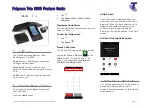
Admin Settings
Admin Settings are divided into five groups—General Settings, Video Network/IP
Network, Global Services, LAN Properties and Graphics Display.
General Settings
System Settings
System Settings allow you to give a name to your QSX (e.g.- You may want to name it
“Pebble Beach Conference Room” if that’s where the unit will be located). You can also
set Low Profile Signaling Protocols (LPSP) based on your expected usage of the QSX
system. For more details on each of these settings, consult the table below.
To configure system settings:
1.
Log on to the QSX Admin Web as described on
Page 23
.
2.
Go to
Admin Settings > General Settings > System Settings
.
3.
Configure these settings:
Setting Description
System Name
(default: serial number)
Specifies the system name in this field. This name is displayed to other
meeting participants.
LPSP Gain
(default: 200)
Specifies the gain for the Low Profile Signaling Protocol (LPSP). Increase
the gain to 300 or 400 if you expect the QSX system to handle international
calls.
If the QSX is to be used in a Stand Alone Mode, configure the LPSP Gain
to zero.
LPSP Delay
(default: 15)
Specifies the delay in seconds for LPSP activation. Increase the delay if
conference bridges that require pass codes are being used. Extra delay
might be necessary to prevent the QSX system from disrupting DTMF
transmission of the audio conference pass codes.
Note:
Low Profile Signaling Protocol (LPSP) is the method that the QSX systems use to
establish a connection with one another. In doing so, they transmit and decode site
identification. The QSX units use a small fraction of the standard 3.5 Hz bandwidth
allocation of a typical POTS call for the LPSP communication.
Security
The QSX system allows you to share content with other meeting participants in a secure
manner. By not transferring files, you ensure that they won’t be accessed by
unauthorized viewers or used in unintended ways. AES (Advanced Encryption Standard)
media encryption in calls between QSX systems ensures that the content is secure
traveling via the Internet or an IP network. Finally, secure login and encrypted password
exchange for web access allows you to restrict who is able to join meetings.
29
















































